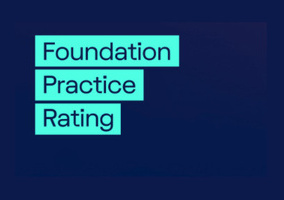The project team were heartened by reactions from around the sector to the launch of the Rating. They said: “We appreciate that most foundations did not ask to be included, and that it comes after an incredibly busy and difficult two years because of the pandemic. We also totally appreciate that many foundations have had a huge amount to cope with – a rise in need, staff shortages, suddenly moving to working from home, to name a few – and that many foundations have radically adapted their processes to the crisis.
“In addition, we know that UK community foundations were undergoing Quality Accreditation – a detailed process – around the same time as receiving the unsolicited research information from us.
“Given all that, the response from foundations has been very encouraging.”
However, Danielle Walker-Palmour, director at Friends Provident Foundation which initiated the project, added that the year-one results confirmed the project team’s suspicions that all trusts and foundations had work to do to raise their standards of performance.
“We and our fellow foundations need to consider not just the content of our grant programmes but also how we communicate with those we support, how accessible our processes are to those in need, and how our governance reflects the world around us.
“From the positive responses we have had thus far we are hopeful that next year’s Rating will show a marked improvement.”
ACF response
Max Rutherford, head of policy and practice at the Association of Charitable Foundations (ACF), welcomed the Rating and was pleased that it set a “fairly high bar”. “As with our own Stronger Foundations work and other initiatives, this isn’t about compliance. This is about more ambitious practice that goes beyond compliance.”
Rutherford agreed that in the past, some foundations have operated in a way that is quite opaque and almost deliberately obstructive – or at least that was the perception. “But I think there is now a recognition that greater transparency can actually be very helpful in reducing bureaucracy and the administrative burden of applications.
“We’ve seen no evidence of any correlation between greater transparency and greater burden – quite the opposite, in fact. A foundation that says very little about what it does and what it funds is more likely to receive unsolicited and irrelevant applications that don’t meet its criteria. Conversely, one that is much clearer about what it funds, and gives very good guidance and has, perhaps, first-stage questionnaires that help to filter out unsuitable applications at an earlier stage, tends to have a much better experience – as do its grant-seekers. So there’s been a definite shift in attitude.”
Rutherford said the shortcomings highlighted by the findings were broadly in line with those evident from ACF’s own engagement with its members.
“Digital delivery is a major area that foundations know they need to improve on, particularly in how they interact with grantseekers. This means moving away from traditional, 20th century methods such as written application forms, postal addresses and fax machines, to making the user experience as smooth and efficient as possible.”
He admitted he was surprised that as many as a quarter of the sampled foundations still didn’t have a website, but posited that this could be down to some foundations’ online information being presented as a section of their corporate parent’s website, or a number of connected family foundations being grouped together on one umbrella portal.
“But I think it’s a valid challenge in those cases to say, ok, you might be featured somewhere on a website or clustered together with other foundations, but is that effective practice? Is that sufficiently helpful for a grant-seeker? Is it not better that you should have your own web presence that is easy to find?”
Similarly, the results on diversity provide a “helpful reminder that the sector still has a long way to travel”, Rutherford said, although he insisted that foundations were waking up to the problem and taking steps to improve.
“There is now a clear consensus that foundations need to significantly step up their game, not just around the demographic diversity of the people that they employ or have on their boards, but the whole way they operate and the way that that relates to accountability and transparency.
“We’ve seen a huge shift in energy around this agenda in the last two or three years. The impetus for change is coming from both within and outside the foundation sector, and we’ve seen some very impressive and impactful initiatives that have come from within the foundation sector, such as Future Foundations UK and Ten Years’ Time, to name just two. But it’s definitely helpful to have more data and what this shows is that as well as having to improve actual diversity, foundations need to get better at telling the story of how they measure diversity, and what sort of information they make available.”
Rutherford concluded that because the Rating is a peer-led piece of work, he expected it would generate high engagement from the sector. “We often find that foundations are most persuaded by a degree of peer pressure and respond well to working collaboratively.”
John Ellerman Foundation response
Sufina Ahmad, director at John Ellerman Foundation – one of the 10 project funders – described the research as “really credible” and was sure that it would galvanise action.
Ahmad said that Ellerman was already making efforts to improve many of its practices; for instance, in 2020 it commissioned its first-ever grantee and applicant perception audit to help it challenge its own assumptions and better understand its effectiveness, including on equity, diversity and inclusion (EDI). But being part of something bigger such as this “helps you excel”, she said.
She added that the Rating research had made her realise that while Ellerman was doing a lot of good things, it wasn’t very good at telling people about them.
“We always have open recruitment and we produce job descriptions and we always show the salary when we’re recruiting, but because we don’t have very high staff turnover, these things aren’t obvious to the outside world,” she said. “So now we’re thinking about where’s the best place for sharing this; should we put them on our website, and if so, where?
“It’s made me think about how much knowledge we are assuming on the part of people looking at us externally. We are assuming that they know we do these things, but of course they don’t.”
But Ahmad also cautioned that while the Rating questions generated some quick wins for Ellerman – such as translating the foundation’s website into Welsh, which took less than a week – many of the criteria were more complex and difficult to achieve, and require careful thought and implementation. The publication of pay gaps in a small team was one such example, while efforts to improve diversity was another. It should be noted that Ellerman was actually exempted from many of the criteria on both pay gap reporting and diversity, because it has a relatively small staff team, but Ahmad is keen that the organisation strives for high standards nonetheless.
“With these types of things, you really need to take people with you,” she said. “For me, the goal has to be getting sustained interest, energy and commitment to an issue, and that just isn’t going to happen in a short space of time. If we rush it, it will become tokenistic.”
Ellerman is taking a “completely holistic approach” to EDI, Ahmad said, encompassing its grantmaking, its investing, and its team and culture. This has sparked some “big and intense discussions”, which take time to assimilate and turn into meaningful action. She agrees that the pace of change is still too slow across the sector generally, but at the same time insists that it is “better to be working in this kind of sustained and committed way rather than a tokenistic and surface-level way, which can actually do a huge amount of damage”.
Albert Hunt Trust response
Ahmad wasn’t the only foundation leader to highlight the challenges of performing well on diversity. Jane Deller Ray is operations manager – the sole staff member – at the Albert Hunt Trust, a 43-year-old family foundation which gives grants across the UK to support hospices, homeless people, and health and wellbeing projects. Its trustee board comprises two white women members of the founding family, plus two “typical white, retired, professional males” who were appointed for their skills and prior professional connections to the Trust. The Albert Hunt Trust was exempted from the Rating’s trustee diversity criteria because it has such a small board, but nonetheless it is still an issue that Deller Ray is alive to.
“We’ve never advertised for trustees externally,” said Deller Ray. “It’s always been led by the family and how they want it to be. So that obviously hampers your ability to be diverse on the board.”
She insisted that the lack of trustee diversity doesn’t adversely affect the Trust’s ability to reach a wide cross-section of beneficiaries, but reflected: “I do take the point about being accessible to different communities which may not have the wherewithal or the expertise to make the application in the first place. But because we are a reactive funder, and a high-volume funder, we simply haven’t got the capacity to specifically source organisations that haven’t yet found us.” That said, the Trust has proactively created relationships with membership bodies such as Hospice UK, Trussell Trust and community foundations in order to promote its funding more widely.
Deller Ray acknowledged that the Rating project has alerted her to issues that hadn’t been high on her agenda previously. “I mean, we haven’t got a social media presence, and we haven’t got a formal complaints process on our website. Maybe that’s something we should think about. But we’ve only had a website for two and a half years; we are quite new in terms of our online presence.”
The website does make clear that if prospective applicants have any questions, they are welcome to pick up the phone and call Ray, which she suspects is not common practice among funders. She added that she has had a lot of good feedback that the online application form is simple to complete. However, now that the Rating research has highlighted the fact that the online form is the only way the Trust allows grant-seekers to apply for funding, she is considering adding a line to the website to say that if anyone has difficulty accessing the form, they should call to request an alternative process.
However, Ray also warns that there is a risk that in trying to improve their own practice, foundations could create more work for grant recipients. In particular, she cites the criterion about measuring the effectiveness of the foundation’s own work.
“We don’t really ask for reporting from our grantees unless we are doing capital funding. We give unrestricted core funding so that they can get on with the job. If we try to measure how well we are doing in terms of supporting different beneficiaries, that means we’re asking them to put in a lot of extra work to demonstrate that. That’s all time and cost.”
She is similarly circumspect about how much time she should devote to considering the Rating criteria when her own working week is finite. “It is right that we will reflect on what we’re doing, and I have made a list of some things I will take to our next board meeting to discuss. But ultimately, we just want to get money out to people.”
Tool for internal review
A happy consequence of the project is that the criteria can be used as a tool for internal review even by those organisations that are not assessed by the researchers.
Community Foundation Tyne & Wear and Northumberland (CFTWN) is the UK’s largest community foundation and although it wasn’t included in the Rating sample this year, its chief executive Rob Williamson looked at the initial project outline during the public consultation and was sufficiently impressed to download the criteria questions and assess the organisation’s practices against them.
Five community foundations were assessed as part of the sample this year, and all five scored at least a B overall (with one, from County Durham, getting one of the three As). Williamson was not surprised by these positive results, explaining that community foundations are required to undergo Quality Accreditation (QA) if they wish to be a member of UK Community Foundations, and many have just completed their fifth iteration of the QA process.
“So, despite the fact that we are smaller and, in some sense, scrappier than some of our older and more established private foundation cousins, some of our practices especially around transparency and accountability have already been looked at as part of that QA process for a number of years.”
But what he particularly liked about the Rating process, he said, was its focus on publicly available information.
“The QA process, like many things that exist in our sector, relies heavily on us submitting evidence to a set of external assessors. We have to compile our portfolio of policies, and send it off. What I liked about the Giving Evidence approach was that it looks at organisations from the stakeholder perspective, whether that be grant applicants or, as in the case of community foundations, potential donors. It looks at what we say about ourselves, what we put out into the world. It’s a different lens to see ourselves through.”
Williamson said that he held up the Rating questions as a mirror to his foundation’s practices “to help us spot what we’re missing”. The organisation is approaching the end of the second year of its current strategy period and the senior team is in the process of setting out priorities and actions for the next year to take to the board. As well as considering its own strategic plan, it has taken inspiration from the Institute for Voluntary Action Research’s Flexible Funders initiative, ACF’s Funder Commitment on Climate Change, and the Foundation Practice Rating criteria. Two areas that CFTWN expects to pay more attention to over the next 12 months as a direct result of the Rating project are grantee feedback and application accessibility.
Williamson added that he found the diversity questions particularly useful, as CFTWN had already been doing a lot of work on EDI but had struggled to find many examples of best practice that it might emulate.
“We knew we wanted to do diversity benchmarking for our staff and trustees, but when I went looking for who else is actually publishing data on the make-up of their staff and trustees in the charity sector, I couldn’t find many examples. I even put a call out on Twitter but didn’t get any response. Acevo and Nesta have done it, but that’s about it.
“So I was really encouraged to see that this was an area that the Rating would be focusing on, because it will not only raise the bar across the piece, but the more people that are doing it, the more it will be helpful for us.”
In fact, now CFTWN intends to go even further than the Rating criteria on reporting staff and trustee diversity. “Their standard looks at gender, ethnicity and disability but we are planning to go beyond that to include sexual orientation, age and socio-economic background,” said Williamson.
Related articles












